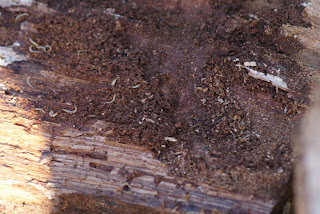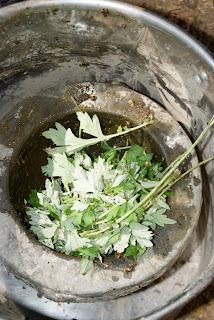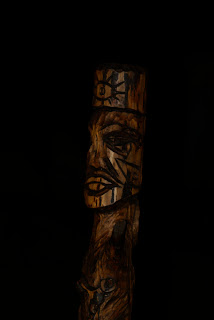In our exploration of some of the misconceptions or myopic understandings that are promoted under the banner of "palo", we begin by looking at a fundamental "ingredient" within the Prenda, and the "ingredient" utilized to make spiritual batons and other objects of spiritual power: The PALO!
A Palo is literally a "stick" which has been cut from a shrub or tree. This stick embodies the Spirit of that shrub or tree, and also contains any medicinal, nutritive, or spiritual properties of the tree or shrub's bark and wood. As Paleros, we first must understand the diversity of trees who live upon the Earth and the broader categories that they can fall into. We are going to first look at the regenerative power of some trees, and then the decay process, and finally the making of a Baton de Muerto.
REGENERATION
With many trees, once the Palo is cut from the tree, the Palo cannot regenerate into another tree, however with some trees the Palo can become another tree, it sends new roots out and then leaves and before long a new tree is present with us. Some trees also regenerate from any section of root left in the earth. Many shrubs also have this ability. In this case, when a Palo is cut, the Palo has the capacity to come to life once again as a tree.
In the three photos below we see a Black Locust tree that regenerated from some locust root pieces left in the Earth. This was the second time they had regenerated. The first time they regenerated was discussed in a prior post titled "Espanta Muerto- Local Options!"
As Paleros, it is obviously of great significance to us whether the Palo we hold in our hands is regenerative as this will have implications as to our use of it. In this case it is a mistake to consider the Palo to be "dead". When we fail to look beyond the name of a Palo and its narrowly prescribed ritual use, we miss out on the greater understanding that is possible when we observe the Tree the Palo is coming from in its natural cycle upon the Earth.
Another wonderful regenerative tree is the willow. Any willow tree will root and grow into a tree. The tree below is a cork screw willow that was grown from a palo that we placed in water in early spring. It grew roots, leaves and as can be seen it has become a growing tree. We can take any of its branches and again root them and grow them into trees. We absolutely cannot consider these regenerative Palo's to be "dead".
Next we can explore a phenomenon that occurs with many trees where the upper portion of the tree or shrub dies or is cut off and the tree looks dead, however after a time new growth comes forth since the root is not dead. This shrub in the photo below appeared to be dead for many years due to the shock of transplanting. However now, 4-5 years later it is finally regenerating. Obviously this has spiritual implications. Again we reiterate that it is vital that we observe the trees and shrubs in "nature"!
Then we had a wind storm which blew most of the dead part of the shrub down giving the new growth more space. However the part we consider "dead" is not really lifeless as we will see next:THE PROCESS OF DECAY:
Once a tree dies or a branch falls off the tree, it begins a process of decay. The process of decay turns the tree from the familiar trunk and branch to soil which contributes to the vital layer of humus that covers our Mother Earth (Ntoto) and enables us to live upon this earth. It is this layer of humus that allows the seed to be nourished and to become a tree.
The decay process occurs through the activity of fungi and micro-organisms that are not visible to the eye. During this process we also see larger organisms who are taking advantage of the decay process to thrive themselves. The tree literally turns to powder or dust. The photos below show the decay of the tree and how it is turning to soil. These photos are from some trees that have been stacked in a pile for about 6 years. What you cannot see in these photos is the tiny micro-organisms that are turning the tree into dust. We can see some white splotches especially in the third photo- that is the mycelium, which is the FUNGI which is essential in the decay process.
Along with the tiny organisms, there are very visible "bugs" of all different appearances and sizes. These particular trees were filled with these large beetles who were eating and making tunnels under the bark.
The tree that had appeared to be "dead" turned out to be teeming with life, as the life of the tree is being transmuted into the life of fungi, microorganisms and insects, and whose "end product", humus will contribute to the fertility of the soil and enable other trees and shrubs to grow!
Here we can see that just below the bark, rich dark soil is forming. This is a soil that does contain great power, not only the spiritual power that the Brujo can direct, but also the power to nourish life.
If we are tracking the Spirit of the tree, we have to question our assumptions concerning a "dead tree". We cannot assume that the Spirit of the tree is not present in the soil that the tree becomes.
Below is a Palo which has be cut from its roots, it could be called "dead" however the white mycelium covering it tells us that it is filled with life! We do our Ancestors an injustice when we, as Paleros, fail to observe life and death in the world around us. The vast majority of our Ancestors were intimately connected to the world of life and death that surged all around them as they were people who worked directly with the Earth.
THE MAKING OF A BATON DE MUERTO:
By making a Baton de Muerto we are slowing the natural process of the tree's decay. The decay is still occurring just at a much slower pace, so that we can utilize the Spirit of the Palo for our Spiritual Purposes. Below we share aspects of a process of creating a Baton de Muerto.
We begin with a PALO, in this case it is from a cherry tree which grows in our land. This tree grows with the blessing of several Mpungo; the Sun (fire, warmth), the Air (wind), the Waters (rain, ocean, river), and the Earth (soil and minerals). Its form and properties are directed by the Spirit within it, represented through out its "body" (roots, trunk, leaves, flowers, fruit) through its DNA which directs its growth and expression. Its texture, aroma, height, density, flowering, fruiting, shape of leaves, branches and root, and its potential to regenerate, are all expressions of its innate Spirit. When the Palo is cut from the tree, it retains its shape, texture, medicinal properties, aroma and so on, and these all indicate the Spirit that is present. When we look at the Palo, we need to also "see" the fire of the Sun, the storms bringing the rains, the seasons, the cool and warm winds, all the things that enabled the Spirit of the tree to express itself in its physical body. We also need to see the Ancestors of that tree, the tree that dropped a fruit that germinated and became that tree. We need to see the community of trees that it belongs to, all the other cherry trees that are growing and also embodying that Spirit.
First the Palo is carved with hand tools, which are both wooden and metal. It is given the blessing of the Mpungo represented by the metal, and also represented by the Ancestral wisdom that gave birth to carving tools. The Spirit and Ancestors of the brujo who is envisioning the carvings and the individual who is actually carving the Baton are also present.
In this process the Ceremonial Fire is essential. Just as the fire of the Sun is essential in the tree's Life, so is the fire essential in the tree's Rebirth into its Spiritual Role within the Munanso.
Many ingredients are utilized in this process, pulling energy from many sources, plant, mineral, life and death. The ashes of the fire represent death. The Ceremonial Fire itself is burning additional trees, plus the fungi, micro-organisms and insects that are in the wood.
The ingredients are pulverized in the mortar, which contains its own Spirit. Ingredients are mixed in jicaras which again represent another Spirit, plus the Ancestral wisdom that brought their use forward to the present time.Various plants are added to the Ceremonial Paste that is being created.
Additionally different elements are added and waters from a variety of different sources.
At another point a concoction is made from black walnuts, from trees that grow within the boundaries of the Munanso. This creates a strong brown dye (which is why we use gloves to handle it), this dye has its own distinct aroma.
Plants are pulverized into a paste. The wide variety of Spiritual energies that are being utilized in the creating of the Baton all enhance the natural Spirit that is already present in the Palo itself.
A Ceremonial paste is created with the many ingredients. This is a potent mixture which will empower the Baton.
The Ceremonial paste is rubbed all over the Baton with the Nkisi of the Munanso, the Sacred Fire, and the Mpungos of the Sun, Air and Earth as witnesses.
Below you can see the transformation that the Ceremonial paste brings to the Baton. The expression significantly changes.
This Ceremonial paste can be handled without gloves as there is nothing dangerous or toxic in it, however the black walnut will stain skin for a couple weeks, so gloves were worn.
At a certain point the Baton was able to stand on its own, unsupported, outside one of the Munansos.
At the base of the Baton a small area is hollowed out for the Bilongo that will be put in.
The Ceremonial paste is rubbed into the Baton so that the Palo itself absorbs the Spiritual Energies.
The Baton is Sprayed with Melafo and Nsunga. Meanwhile the Ceremonial Fire continues to bring its blessings and power to the process.
During this process various insects fly onto the baton, some becoming absorbed into it.
This process is repeated several times.
More ingredients are then prepared for the Baton, these are very aromatic plants and flowers.
And, we note carefully any insects or animals that make themselves know. Here a spider appears on a plant from the Spiritual Bath.
Plants from the Spiritual Bath are also pulverized in the mortar.
We also do not want to ignore what time of year the Baton is being created. This Baton is being created in the summer, and all the trees are in full leaf.
Here the Baton stands by itself as various Nkisi and Cemis observe it.The Baton receives its Spiritual Bath, again note its changing expression.
Finally walnuts are made into a dye that is brushed onto the Baton. Again, this dye could be applied without gloves directly by hand, but the result would be stained hands.
The Spirit of the Baton comes more and more into focus as the process continues. The Baton is placed at various different points in the Munanso. Here it spends time with the Central Ceremonial Tree.
Here the Baton stands by a Living Tree within the Munanso right by the intersection of two pathways into the Munanso clearing.
The chivo patiently waits...
At night a ceremonial fire is made in one of the Bateys. The Baton is placed within the Fire Circle and is empowered by the energies of the night.
We watch the fire closely to see the various Spirits that manifest within its smoke and flames. The fire is telling us about the energies of the Baton and the Sprits that are present.
Right within the Fire's flames, Spirits manifest. Let us consider that the flames and heat are the expression of the Sun's energy that had become embodied within the trees that became the logs that we used to make the fire- the same Sun that empowered the Palo to grow in the first place.
The Baton is absorbing the Spirit of the Fire, the Energies of the night, the smoke of the fire, the heat of the fire. Look closely at the flames to see the Spirit that is present. It is a powerful Ceremonial moment.
The fire itself goes through its transformations, slowly becoming a mature fire, and showing the transformation of the logs from tree to ash.
Here the ash on the logs is reminiscent of the white mycelium that covers the decaying logs. Both the natural decay process, and the natural process of decay through fire, are fascinating processes to observe.
This is a powerful night for the Baton to be empowered by the Sacred Fire as it is a Full Moon Night and it is a bright full moon because the sky is very clear.
Just as the Baton takes in the Lunar Energy and the Energy of the Night, it also takes in the full Rays of the Sun and the Energies of the Day.
In the day we look at the ashes of the fire, as they themselves tell us story and give us a divination concerning the Baton.
In our Munanso we strive to always come to a greater appreciation and understanding for the Spiritual Energies and Ancestors that we are working with. Within this process, observation is essential. Every day we observe a new phenomenon in the land around us, and every season brings greater insight. As Paleros we must never become complacent in our knowledge, but always seek to deepen it. These are just some of our insights and thoughts on Palos in Palo Mayombe!













































































No comments:
Post a Comment